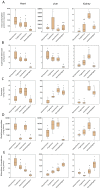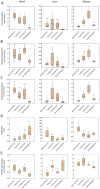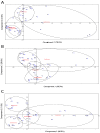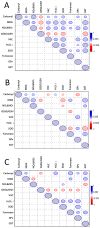Oxidative Stress and Antioxidant Defense in the Heart, Liver, and Kidney of Bat Species with Different Feeding Habits
- PMID: 38003558
- PMCID: PMC10671108
- DOI: 10.3390/ijms242216369
Oxidative Stress and Antioxidant Defense in the Heart, Liver, and Kidney of Bat Species with Different Feeding Habits
Abstract
The aim of this study was to compare the oxidative metabolism of four neotropical bat species with different feeding habits and investigate the relationship between their feeding habits and oxidative status. In terms of oxidative damage, our findings revealed major differences among the four bat species. In particular, hematophagous bats had lower levels of oxidative damage in the heart but higher levels in the liver. Nectarivorous bats had lower levels of carbonyl groups in the kidneys compared to insectivorous and hematophagous bats. The activity of various antioxidant and non-antioxidant enzymes in the heart, liver, and kidney also showed significant differences among the bat species. H2O2 consumption was lower in the heart of hematophagous bats, while insectivorous bats exhibited the highest enzymatic activity in the kidney. SOD activity was lower in the heart of hematophagous bats and lower in nectarivorous bats in the liver. Fumarase activity was higher in the heart of frugivorous/insectivorous and lower in nectarivorous/hematophagous bats. GPx activity was higher in the heart of nectarivorous/insectivorous and higher in the kidney of insectivorous bats. GST activity was higher in the heart of nectarivorous and lower in hematophagous bats. The correlation analysis between oxidative markers and enzymatic/non-enzymatic antioxidants in the heart, liver, and kidney exhibited distinct patterns of correlations due to variations in antioxidant defense mechanisms and oxidative stress responses in different organs. The observed differences in oxidative damage, antioxidant enzyme activities, and correlations between oxidative markers and antioxidants highlight the adaptability and complexity of the antioxidant defense systems in these bats. Each organ appears to have specific demands and adaptations to cope with oxidative stress based on its physiological functions and exposure to dietary components. Our results have major significance for the conservation and management of bats, which are threatened species despite being crucial components of ecosystems. Our study's implications go beyond bat biology and offer valuable insights into comparative oxidative physiology.
Keywords: animal nutrition; diet; frugivorous; hematophagous; insectivorous; nectarivorous; oxidative stress.
Conflict of interest statement
The authors declare no conflict of interest.
Figures





Similar articles
-
Distribution and Utilization of Vitamin E in Different Organs of Wild Bats from Different Food Groups.Life (Basel). 2024 Feb 17;14(2):266. doi: 10.3390/life14020266. Life (Basel). 2024. PMID: 38398775 Free PMC article.
-
Oxidative Stress and Antioxidant Defense in the Brain of Bat Species with Different Feeding Habits.Int J Mol Sci. 2023 Jul 29;24(15):12162. doi: 10.3390/ijms241512162. Int J Mol Sci. 2023. PMID: 37569536 Free PMC article.
-
Comparative study of endocrine pancreatic tissue in bats: Assessing variations among frugivorous, insectivorous, and nectarivorous diets.Tissue Cell. 2024 Jun;88:102413. doi: 10.1016/j.tice.2024.102413. Epub 2024 May 17. Tissue Cell. 2024. PMID: 38772274
-
Recent epidemiologic, clinical, subclinical and genetic diversity of Toxoplasma gondii infections in bats.Res Vet Sci. 2021 Nov;140:193-197. doi: 10.1016/j.rvsc.2021.09.006. Epub 2021 Sep 8. Res Vet Sci. 2021. PMID: 34521027 Review.
-
[Bats and Viruses: complex relationships].Bull Soc Pathol Exot. 2015 Oct;108(4):272-89. doi: 10.1007/s13149-015-0448-z. Epub 2015 Sep 1. Bull Soc Pathol Exot. 2015. PMID: 26330152 Free PMC article. Review.
Cited by
-
PANoptosis Regulation in Reservoir Hosts of Zoonotic Viruses.Viruses. 2024 Nov 4;16(11):1733. doi: 10.3390/v16111733. Viruses. 2024. PMID: 39599847 Free PMC article. Review.
-
Bat Ecology and Microbiome of the Gut: A Narrative Review of Associated Potentials in Emerging and Zoonotic Diseases.Animals (Basel). 2024 Oct 21;14(20):3043. doi: 10.3390/ani14203043. Animals (Basel). 2024. PMID: 39457973 Free PMC article. Review.
-
Distribution and Utilization of Vitamin E in Different Organs of Wild Bats from Different Food Groups.Life (Basel). 2024 Feb 17;14(2):266. doi: 10.3390/life14020266. Life (Basel). 2024. PMID: 38398775 Free PMC article.
-
Comparative Analysis of the Gut Microbiota of Bat Species with Different Feeding Habits.Biology (Basel). 2024 May 22;13(6):363. doi: 10.3390/biology13060363. Biology (Basel). 2024. PMID: 38927243 Free PMC article.
References
-
- Aziz S.A., McConkey K.R., Tanalgo K., Sritongchuay T., Low M.-R., Yong J.Y., Mildenstein T.L., Nuevo-Diego C.E., Lim V.C., Racey P.A. The Critical Importance of Old World Fruit Bats for Healthy Ecosystems and Economies. Front. Ecol. Evol. 2021;9:641411. doi: 10.3389/fevo.2021.641411. - DOI
-
- Fuloria S., Subramaniyan V., Karupiah S., Kumari U., Sathasivam K., Meenakshi D.U., Wu Y.S., Sekar M., Chitranshi N., Malviya R., et al. Comprehensive Review of Methodology to Detect Reactive Oxygen Species (ROS) in Mammalian Species and Establish its Relationship with Antioxidants and Cancer. Antioxidants. 2021;10:128. doi: 10.3390/antiox10010128. - DOI - PMC - PubMed
-
- Orr T.J., Ortega J., Medellín R.A., Sánchez C.D., Hammond K.A. Diet Choice in Frugivorous Bats: Gourmets or Operational Pragmatists? J. Mammal. 2016;97:1578–1588. doi: 10.1093/jmammal/gyw122. - DOI
MeSH terms
Substances
LinkOut - more resources
Full Text Sources
Research Materials

